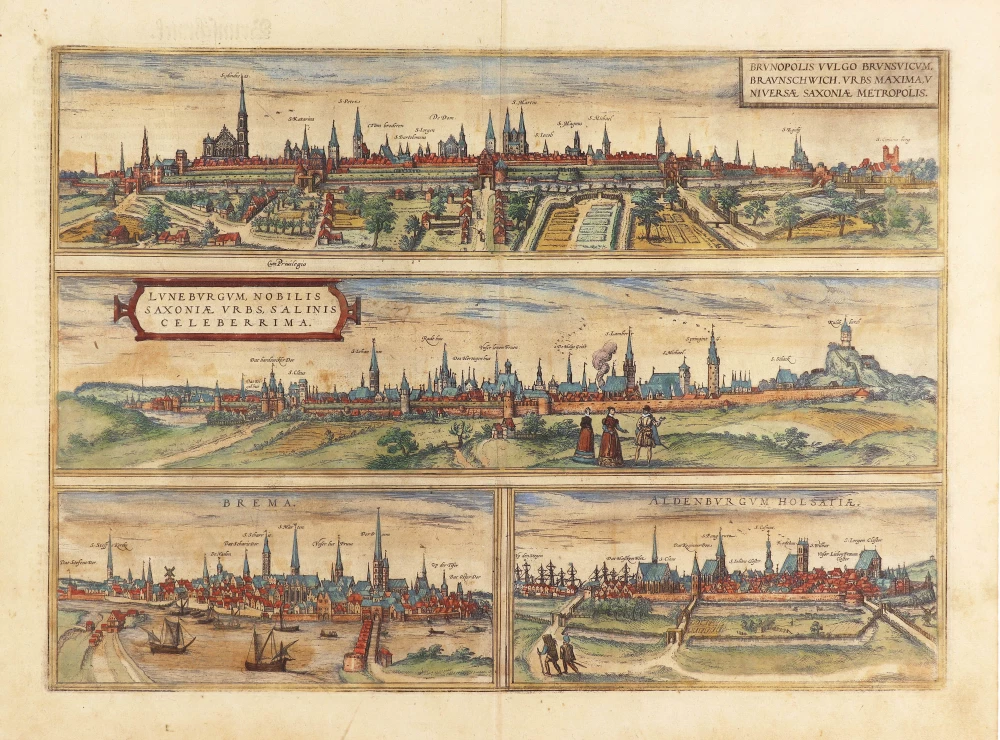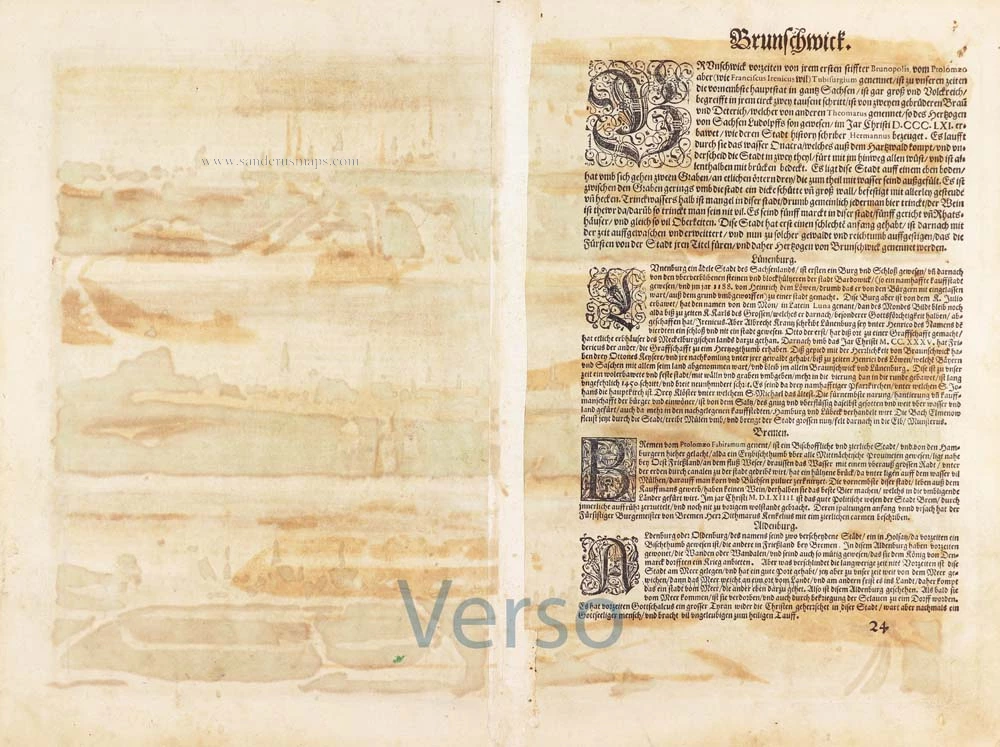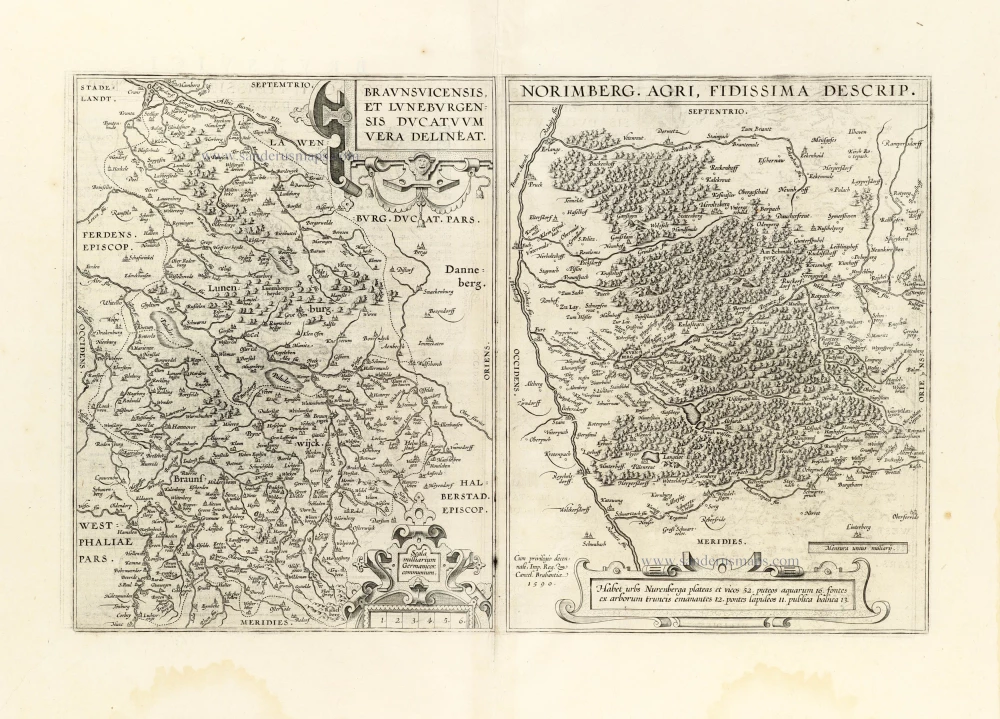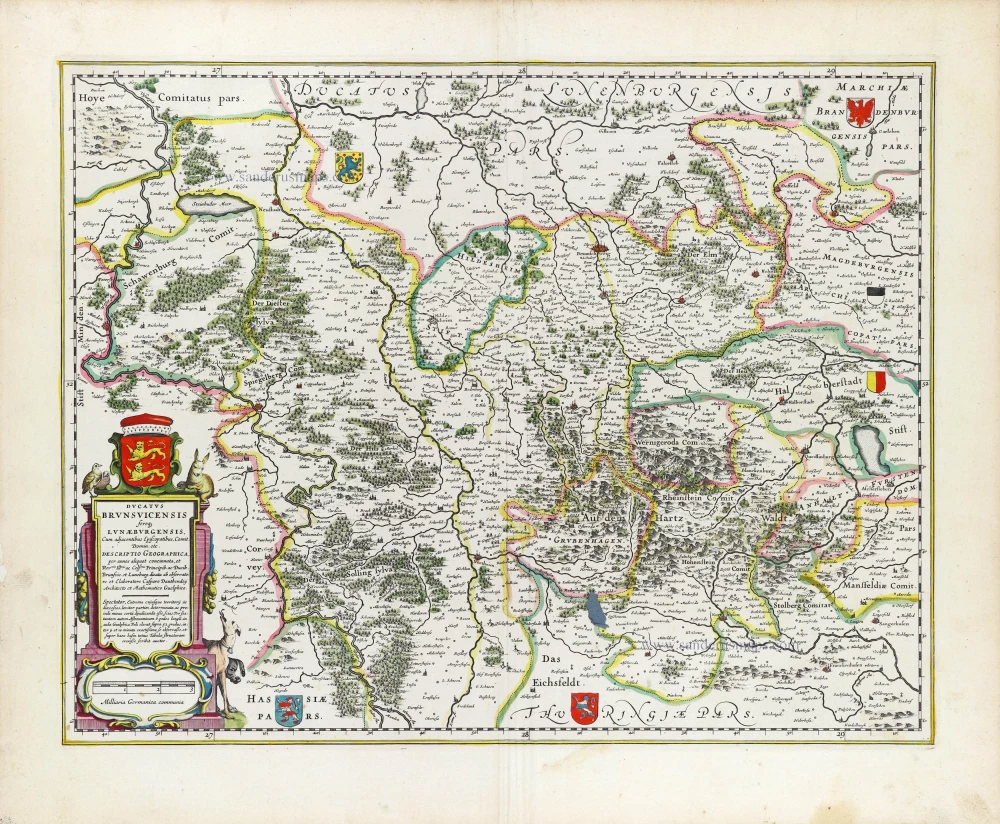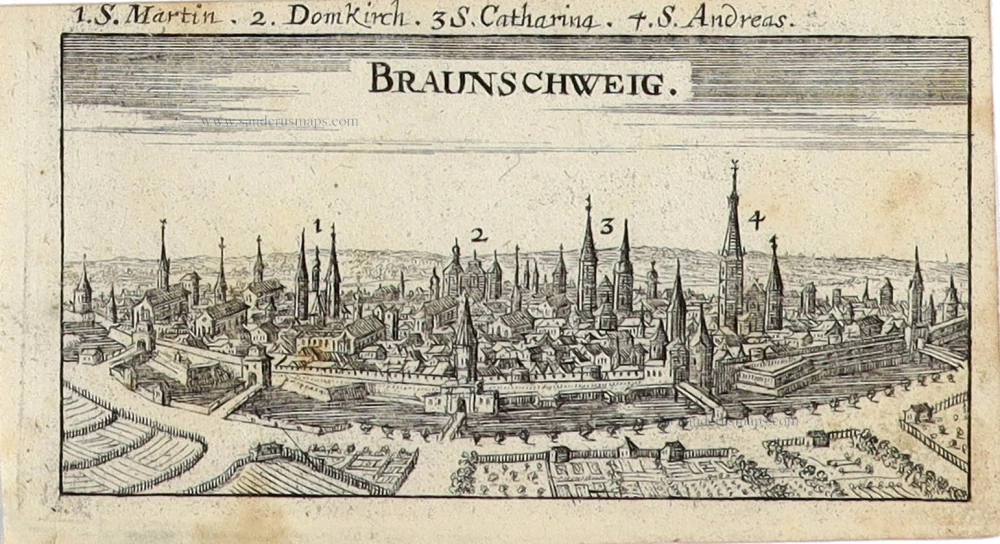Braunschweig, Luneburg, Bremen, and Stade, by Georg Braun and Frans Hogenberg. 1582
BRAUNSCHWEIG
TRANSLATION OF CARTOUCHE TEXT: Brunopolis, commonly known as Braunschweig, the largest city in all of Saxony.
COMMENTARY BY BRAUN: "The Oker, which comes from the Harz Mountains, flows through Brunswick and divides the city into two halves. It carries away all the city's dirt and is crossed everywhere by bridges. The city lies on flat land, surrounded by two and, in some places, even three moats. Between the moats around the city, there is a broad earth mound and a large embankment that is stabilized by various bushes and hedges. [...] There are five markets in this city, five law courts, town halls, and as many magistracies."
The shallow viewpoint allows the tops of the towers, churches, and houses to be seen. The most striking of these is the church of St Andreas on the left with its two towers. Close to the centre lies the cathedral (De Dom), begun by the Guelph Henry the Lion beside his Dankwarderode castle in 1173 and consecrated in 1226. Although the city is considered to have been founded by Duke Bruno in the 9th century, it was under Henry the Lion that Brunswick became a princely residence. The five different markets, administrative offices, law courts and town halls mentioned by Braun testify to the fact that Brunswick originally comprised five distinct districts, which were subsequently united under Henry the Lion.
LÜNEBURG
CARTOUCHE: Lüneburg, a well-known city in Saxony, is highly famed for its salt mines.
COMMENTARY BY BRAUN: "This city, well built and fortified in our day, is surrounded by walls and moats; it is sooner rectangular than round, about 1450 paces long and 900 wide. There are three important parish churches here, including the main church of St John and three monasteries, of which St Michael's is the oldest. Of greatest importance for the prosperity, employment and trade of all the burghers and inhabitants is salt, which is abundant and boiled and exported far away by water and land, including to the nearby trade cities of Hamburg and Lübeck. The small Ilmenau River runs through the city, drives the watermills and does the city great service before flowing into the Elbe."
BREMEN
COMMENTARY BY BRAUN: "Bremen, called Fabiranum by Claudius Ptolemy, is a beautiful cathedral city. Following the destruction of Hamburg by the Vikings, the diocese was moved here, and Bremen became the archdiocese for all the northern church provinces. Bremen lies near East Friesland and on the River Weser. The water is pumped into the city from outside via underground channels using a huge wheel; it has a wooden bridge, beneath which stand numerous watermills which grind wheat and gunpowder. The noblest burghers of this city make their living from commerce; because the people of Bremen have no wine, they brew the best beer, which is exported to neighbouring lands."
This view is made after a woodcut by Martin Weigel, c. 1550.
STADE
Contrary to the plate's title - Aldenburgum Hosatiae - the view shows the town of Stade in Lower Saxony, as can be deduced from the captions identifying the buildings and churches and from a comparison with the full-page illustration of Stade.
Braun G. & Hogenberg F. and the Civitates Orbis Terrarum.
The Civitates Orbis Terrarum, also known as the 'Braun & Hogenberg', is a six-volume town atlas and the most excellent book of town views and plans ever published: 363 engravings, sometimes beautifully coloured. It was one of the best-selling works in the last quarter of the 16th century. Georg Braun, a skilled writer, wrote the text accompanying the plans and views on the verso. Many plates were engraved after the original drawings of a professional artist, Joris Hoefnagel (1542-1600). The first volume was published in Latin in 1572 and the sixth in 1617. Frans Hogenberg, a talented engraver, created the tables for volumes I through IV, and Simon van den Neuwel made those for volumes V and VI. Other contributors were cartographers Daniel Freese and Heinrich Rantzau, who provided valuable geographical information. Works by Jacob van Deventer, Sebastian Münster, and Johannes Stumpf were also used as references. Translations appeared in German and French, making the atlas accessible to a broader audience.
Since its original publication of volume 1 in 1572, the Civitates Orbis Terrarum has left an indelible mark on the history of cartography. Seven more editions followed the first volume in 1575, 1577, 1582, 1588, 1593, 1599, and 1612. Vol.2, initially released in 1575, saw subsequent editions in 1597 and 1612. The subsequent volumes, each a treasure trove of historical insights, graced the world in 1581, 1588, 1593, 1599, and 1606. The German translation of the first volume, a testament to its widespread appeal, debuted in 1574, followed by the French edition in 1575.
Several printers were involved: Theodor Graminaeus, Heinrich von Aich, Gottfried von Kempen, Johannis Sinniger, Bertram Buchholtz, and Peter von Brachel, all of whom worked in Cologne.
Georg Braun (1541-1622)
Georg Braun, the author of the text accompanying the plans and views in the Civitates Orbis Terrarum, was born in Cologne in 1541. After his studies in Cologne, he entered the Jesuit Order as a novice, indicating his commitment to learning and intellectual pursuits. In 1561, he obtained his bachelor's degree; in 1562, he received his Magister Artium, further demonstrating his academic achievements. Although he left the Jesuit Order, he continued his studies in theology, gaining a licentiate in theology. His theological background likely influenced the content and tone of the text in the Civitates Orbis Terrarum, adding a unique perspective to the work.
Frans Hogenberg (1535-1590)
Frans Hogenberg was a Flemish and German painter, engraver, and mapmaker. He was born in Mechelen as the son of Nicolaas Hogenberg.
By the end of the 1560s, Frans Hogenberg was employed upon Abraham Ortelius's Theatrum Orbis Terrarum, published in 1570; he is named an engraver of numerous maps. In 1568, he was banned from Antwerp by the Duke of Alva and travelled to London, where he stayed a few years before emigrating to Cologne. He immediately embarked on his two most important works, the Civitates, published in 1572 and the Geschichtsblätter, which appeared in several series from 1569 until about 1587.
Thanks to large-scale projects like the Geschichtsblätter and the Civitates, Hogenberg's social circumstances improved with each passing year. He died as a wealthy man in Cologne in 1590.
Brunopolis vulgo Brunsvicum, ... [on sheet with] Luneburgum, Nobilis Saxoniae Urbs, ... [and] Brema [and] Aldenburgum Holsatiae
Item Number: 28938 Authenticity Guarantee
Category: Antique maps > Europe > Germany - Cities
Old, antique bird’s-eye view plan of Braunschweig, Luneburg, Bremen, and Stade, by Georg Braun and Frans Hogenberg.
Title: Brunopolis vulgo Brunsvicum, ... [on sheet with] Luneburgum, Nobilis Saxoniae Urbs, ... [and] Brema [and] Aldenburgum Holsatiae.
First state (without privilege)
Date of the first edition: 1572.
Date of this map: 1582.
Copper engraving, printed on paper.
Map size: 340 x 475mm (13.39 x 18.7 inches).
Sheet size: 400 x 530mm (15.75 x 20.87 inches).
Verso: German text.
Condition: Age-toned and stained.
Condition Rating: B.
From: Beschreibung und Contrafactur der vornembster Stät der Welt. [Part 1] Cologne, Gottfried von Kempen, 1582. (Van der Krogt 4, 41:2.1)
BRAUNSCHWEIG
TRANSLATION OF CARTOUCHE TEXT: Brunopolis, commonly known as Braunschweig, the largest city in all of Saxony.
COMMENTARY BY BRAUN: "The Oker, which comes from the Harz Mountains, flows through Brunswick and divides the city into two halves. It carries away all the city's dirt and is crossed everywhere by bridges. The city lies on flat land, surrounded by two and, in some places, even three moats. Between the moats around the city, there is a broad earth mound and a large embankment that is stabilized by various bushes and hedges. [...] There are five markets in this city, five law courts, town halls, and as many magistracies."
The shallow viewpoint allows the tops of the towers, churches, and houses to be seen. The most striking of these is the church of St Andreas on the left with its two towers. Close to the centre lies the cathedral (De Dom), begun by the Guelph Henry the Lion beside his Dankwarderode castle in 1173 and consecrated in 1226. Although the city is considered to have been founded by Duke Bruno in the 9th century, it was under Henry the Lion that Brunswick became a princely residence. The five different markets, administrative offices, law courts and town halls mentioned by Braun testify to the fact that Brunswick originally comprised five distinct districts, which were subsequently united under Henry the Lion.
LÜNEBURG
CARTOUCHE: Lüneburg, a well-known city in Saxony, is highly famed for its salt mines.
COMMENTARY BY BRAUN: "This city, well built and fortified in our day, is surrounded by walls and moats; it is sooner rectangular than round, about 1450 paces long and 900 wide. There are three important parish churches here, including the main church of St John and three monasteries, of which St Michael's is the oldest. Of greatest importance for the prosperity, employment and trade of all the burghers and inhabitants is salt, which is abundant and boiled and exported far away by water and land, including to the nearby trade cities of Hamburg and Lübeck. The small Ilmenau River runs through the city, drives the watermills and does the city great service before flowing into the Elbe."
BREMEN
COMMENTARY BY BRAUN: "Bremen, called Fabiranum by Claudius Ptolemy, is a beautiful cathedral city. Following the destruction of Hamburg by the Vikings, the diocese was moved here, and Bremen became the archdiocese for all the northern church provinces. Bremen lies near East Friesland and on the River Weser. The water is pumped into the city from outside via underground channels using a huge wheel; it has a wooden bridge, beneath which stand numerous watermills which grind wheat and gunpowder. The noblest burghers of this city make their living from commerce; because the people of Bremen have no wine, they brew the best beer, which is exported to neighbouring lands."
This view is made after a woodcut by Martin Weigel, c. 1550.
STADE
Contrary to the plate's title - Aldenburgum Hosatiae - the view shows the town of Stade in Lower Saxony, as can be deduced from the captions identifying the buildings and churches and from a comparison with the full-page illustration of Stade.
Braun G. & Hogenberg F. and the Civitates Orbis Terrarum.
The Civitates Orbis Terrarum, also known as the 'Braun & Hogenberg', is a six-volume town atlas and the most excellent book of town views and plans ever published: 363 engravings, sometimes beautifully coloured. It was one of the best-selling works in the last quarter of the 16th century. Georg Braun, a skilled writer, wrote the text accompanying the plans and views on the verso. Many plates were engraved after the original drawings of a professional artist, Joris Hoefnagel (1542-1600). The first volume was published in Latin in 1572 and the sixth in 1617. Frans Hogenberg, a talented engraver, created the tables for volumes I through IV, and Simon van den Neuwel made those for volumes V and VI. Other contributors were cartographers Daniel Freese and Heinrich Rantzau, who provided valuable geographical information. Works by Jacob van Deventer, Sebastian Münster, and Johannes Stumpf were also used as references. Translations appeared in German and French, making the atlas accessible to a broader audience.
Since its original publication of volume 1 in 1572, the Civitates Orbis Terrarum has left an indelible mark on the history of cartography. Seven more editions followed the first volume in 1575, 1577, 1582, 1588, 1593, 1599, and 1612. Vol.2, initially released in 1575, saw subsequent editions in 1597 and 1612. The subsequent volumes, each a treasure trove of historical insights, graced the world in 1581, 1588, 1593, 1599, and 1606. The German translation of the first volume, a testament to its widespread appeal, debuted in 1574, followed by the French edition in 1575.
Several printers were involved: Theodor Graminaeus, Heinrich von Aich, Gottfried von Kempen, Johannis Sinniger, Bertram Buchholtz, and Peter von Brachel, all of whom worked in Cologne.
Georg Braun (1541-1622)
Georg Braun, the author of the text accompanying the plans and views in the Civitates Orbis Terrarum, was born in Cologne in 1541. After his studies in Cologne, he entered the Jesuit Order as a novice, indicating his commitment to learning and intellectual pursuits. In 1561, he obtained his bachelor's degree; in 1562, he received his Magister Artium, further demonstrating his academic achievements. Although he left the Jesuit Order, he continued his studies in theology, gaining a licentiate in theology. His theological background likely influenced the content and tone of the text in the Civitates Orbis Terrarum, adding a unique perspective to the work.
Frans Hogenberg (1535-1590)
Frans Hogenberg was a Flemish and German painter, engraver, and mapmaker. He was born in Mechelen as the son of Nicolaas Hogenberg.
By the end of the 1560s, Frans Hogenberg was employed upon Abraham Ortelius's Theatrum Orbis Terrarum, published in 1570; he is named an engraver of numerous maps. In 1568, he was banned from Antwerp by the Duke of Alva and travelled to London, where he stayed a few years before emigrating to Cologne. He immediately embarked on his two most important works, the Civitates, published in 1572 and the Geschichtsblätter, which appeared in several series from 1569 until about 1587.
Thanks to large-scale projects like the Geschichtsblätter and the Civitates, Hogenberg's social circumstances improved with each passing year. He died as a wealthy man in Cologne in 1590.

